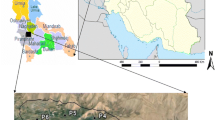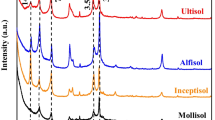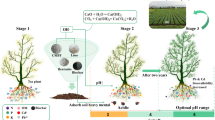Abstract
The effect of a tea plantation on soil basic properties, chemical and mineralogical compositions, and magnetic properties of Alfisols from eastern China was studied. Under the tea plantation, acidification took place within a soil depth of 70 cm, with the maximum difference in pH in the upper 17 cm (ΔpH = 2.80). Both the tea plantation and unused soil profiles were predominated by free Fe and Al oxides, i.e. citrate/bicarbonate/dithionite extractable Fe (Fed) and Al (Ald). Tea plantation soil was characterized by higher Ald and Fed and lower Fe oxalate, Fe2O3 and Al2O3; CaO was depleted, whereas SiO2 accumulated. Acidification induced by the tea plantation led to destruction of vermiculite followed by dissolution of the hydroxy-Al interlayers within its structure. The data clearly demonstrated that significant soil weathering occurred with acidification caused by tea cultivation. This acidification also resulted in decreased content of ferrimagnetic minerals due to the dissolution of minerals and movement of Fe in the profile.






Similar content being viewed by others
References
Abe, S. S., Hashi, I., Masunaga, T., Yamamoto, S., Honna, T., & Wakatsuki, T. (2006). Soil profile alteration in a brown forest soil under high-input tea cultivation. Plant Product Science, 9, 457–461.
Barnhisel, R. I., & Bertsch, P. M. (1989). Chlorites and hydroxyl-interlayered vermiculite and smectite. In J. B. Dixon & S. B. Weed (Eds.), Minerals in soil environment (pp. 729–788). SSSA Book Series No. 1.
Chen, J., An, Z. S., & Head, J. (1999). Variation of Rb/Sr ratios in the loess–paleosol sequences of Central China during the last 130,000 years and their implications for monsoon paleoclimatology. Quaternary Research, 51, 215–219.
Dearing, J. A., Dann, R. J. L., Lees, J. A., Loveland, P. J., Maher, B. A., & O’Grady, K. (1996). Frequency dependent susceptibility measurements of environmental materials. Geophysical Journal International, 124, 228–240.
Ding, R. X., & Huang, X. (1991). Biogeochemical cycle of aluminum and fluorine in tea garden soil system and its relationship to soil acidification. Acta Pedologica Sinica, 28(3), 229–236. (in Chinese).
Dong, D. M., Xie, Z. L., & Du, Y. G. (2001). The bioavailability of Al in soils to tea plants. Applied Geochemistry, 16, 1413–1418.
Evans, M., & Heller, F. (2003). Environmental magnetism principles and applications of enviromagnetics (293 p). London: Academic Press.
Fung, K. F., Carr, H. P., Zhang, J., & Wong, M. H. (2008). Growth and nutrient uptake of tea under different aluminium concentration. Journal of the Science of Food and Agriculture, 88, 1582–1591.
Fung, K. F., Zhang, Z. Q., Wong, J. W. C., & Wong, M. H. (2003). Aluminum and fluoride concentrations of three tea varieties growing at Lantau Island, Hong Kong. Environmental Geochemistry and Health, 25, 219–232.
Gallet, S., Jahn, B. M., & Torii, M. (1996). Geochemical characterization of the Luochuan loess–paleosol sequence, China, and paleoclimatic implications. Chemical Geology, 133, 67–88.
Guicharnaud, R., & Paton, G. I. (2006). An evaluation of acid deposition on cation leaching and weathering rates of an Andosol and a Cambisol. Journal Geochemical Exploration, 88, 279–283.
Han, W. Y., Kemmitt, S. J., & Brookes, P. C. (2007). Soil microbial biomass and activity in Chinese tea gardens of varying stand age and productivity. Soil Biology and Biochemistry, 39, 1468–1478.
Herre, A., Lang, F., Siebe, C., Dohrmann, R., & Kaupenjohann, M. (2007). Mechanisms of acid buffering and formation of secondary minerals in vitric Andosols. European Journal of Soil Science, 58, 431–444.
Liu, Q. S., Banerjee, S. K., Jackson, M. J., Zhu, R., & Pan, Y. (2002). A new method in mineral magnetism for the separation of weak antiferromagnetic signal from a strong ferrimagnetic background. Geophysical Research Letters, 29, 1565–1568.
Ma, L. F., Shi, Y. Z., & Ruan, J. Y. (2000). Soil pHs in the tea gardens in Jiangsu, Zhejiang, and Anhui provinces and changes of soil pH in the past decade. Chinese Journal of Soil Science, 31, 205–207. (in Chinese).
Maher, B. A. (1988). Magnetic properties of some synthetic submicron magnetites. Geophysical Journal, 94, 83–96.
Maher, B. A. (2008). Environmental magnetism and climate change. Contemporary Physics, 48, 247–274.
Maher, B. A., Alekseev, A., & Alekseeva, T. (2003). Magnetic mineralogy of soils across the Russian steppe: Climatic dependence of pedogenic magnetite formation. Palaeogeography, Palaeoclimatology, Palaeoecology, 201, 321–341.
Maher, B.A., & Thompson, R. (1999). Quaternary climates, environments and magnetism (390 p). Cambridge: Cambridge University Press.
Nakao, A., Funakawa, S., & Kosaki, T. (2009). Hydroxy-Al polymers block the frayed edge sites of illitic minerals in acid soils: Studies in southwestern Japan at various weathering stages. European Journal of Soil Science, 60, 127–138.
Obukhov, A. I., Metreveli, A. Z., & Barabadze, L. A. (1982). Influence of long and systematic application of fertilizers on chemistry of red soils. Vestnik of Moscow University, 4, 36–43. serie 17 (pedology) (in Russian).
Oh, K., Kato, T., Li, Z. P., & Li, F. Y. (2006). Environmental problems from tea cultivation in Japan and a control measure using calcium cyanamide. Pedosphere, 16, 770–777.
Özdemir, Ö., & Banerjee, S. K. (1982). A preliminary magnetic study of soil samples from west-central Minnesota. Earth Planetary Science Letters, 59, 393–403.
Pierson-Wickmann, A. C., Aquilina, L., Martin, C., Ruiz, L., Molénat, J., et al. (2009a). High chemical weathering rates in first-order granitic catchments induced by agricultural stress. Chemical Geology, 265, 369–380.
Pierson-Wickmann, A. C., Aquilina, L., Weyer, C., Molénat, J., Lischeid, G., et al. (2009b). Acidification processes and soil leaching influenced by agricultural practices revealed by strontium isotopic ratios. Geochimica et Cosmochimica Acta, 73, 4688–4704.
Rich, C. I. (1968). Hydroxy interlayers in expansible layer silicates. Clays and Clay Minerals, 16, 15–30.
Robert, M. (1995). Aluminum toxicity: a major stress for microbes in the environment. In P. M. Huang, J. Berthelin, J.-M. Bollag, W. B. McGill, & A. L. Page (Eds.), Environmental impact of soil component interactions, Volume II Metals, other inorganics, and microbial activities (pp. 227–242). Boca Raton: CRC Press.
Ruan, J. Y., Ma, L. F., & Shi, Y. Z. (2006). Aluminium in tea plantations: Mobility in soils and plants, and the influence of nitrogen fertilization. Environmental Geochemistry and Health, 28, 519–528.
Ruan, J. Y., Ma, L. F., Shi, Y. Z., & Zhang, F. S. (2004). Effect of litter incorporation and nitrogen fertilization on the contents of extractable aluminum in the rhizosphere soil of tea plant (Camellia sinensis (L.) O. Kuntze). Plant and Soil, 263, 283–296.
Ruan, J. Y., Zhang, F. S., & Wong, M. H. (2000). Effect of nitrogen and phosphorus sources on the growth, nutrient uptake and rhizosphere soil properties of Camellia sinensis L. Plant and Soil, 223, 63–71.
Senapati, B. K., Lavelle, P., Giri, S., Pashanasi, B., Alegre, J., Decaëns, T., et al. (1999). In-soil technologies for tropical ecosystems. In P. Lavelle, et al. (Eds.), Earthworm management in tropical agroecosystems (pp. 199–237). Wallingford, U.K.: CAB International.
Sheldon, N. D., Retallack, G. J., & Tanaka, S. (2002). Geochemical climofunctions from North American soils and application to paleosols across the Eocene–Oligocene boundary in Oregon. Journal of Geology, 110, 687–696.
Sheldon, N. D., & Tabor, N. J. (2009). Quantitative paleoenvironmental and paleoclimatic reconstruction using paleosols. Earth-Science Reviews, 95, 1–52.
Starr, M., & Lindroos, A. J. (2006). Changes in the rate of release of Ca and Mg and normative mineralogy due to weathering along a 5300-year chronosequence of boreal forest soils. Geoderma, 133, 269–280.
Thompson, R., & Oldfield, F. (1986). Environmental magnetism (p. 230). London: George Allen and Unwin.
Ulrich, B. (1991). An ecosystem approach to soil acidification. In B. Ulrich & M. E. Sumner (Eds.), Soil acidity (pp. 28–79). Berlin: Springer.
Wang, X. J., Hu, X. F., & Chen, H. Z. (1997). Some biogeochemical characteristics of tea soils. Pedosphere, 3, 275–280.
Wu, W. H., Xie, Z. M., Xu, J. M., Liu, X. Y., & Zhang, Z. X. (2006). Distribution of aluminum and fluoride in subtropical hilly red soils of tea plantation and its influential factors. Environmental Science, 27(3), 544–549. (in Chinese).
Xu, R. K., Zhao, A. Z., Li, Q. M., Kong, X. L., & Ji, G. L. (2003). Acidity regime of the red soils in a subtropical region of southern China under field conditions. Geoderma, 15, 75–84.
Zhang, M. K., & Fang, L. P. (2007). Tea plantation-induced activation of soil heavy metals. Communications in Soil Science and Plant Analysis, 38, 1467–1478.
Zhang, M. K., Zhou, C., & Huang, C. Y. (2006). Relationship between extractable metals in acid soils and metals taken up by tea plants. Communications in Soil Science and Plant Analysis, 37, 347–361.
Acknowledgments
This study was financially supported by RFBR (Russia)-NSFC (China) foundations (04-04-39015) and the National Natural Science Foundation of China (30872009). We are very grateful to Professor B. Maher (Centre for Environmental Magnetism and Paleomagnetism, Lancaster University, UK) for the opportunity to use the equipment.
Author information
Authors and Affiliations
Corresponding author
Rights and permissions
About this article
Cite this article
Alekseeva, T., Alekseev, A., Xu, RK. et al. Effect of soil acidification induced by a tea plantation on chemical and mineralogical properties of Alfisols in eastern China. Environ Geochem Health 33, 137–148 (2011). https://doi.org/10.1007/s10653-010-9327-5
Received:
Accepted:
Published:
Issue Date:
DOI: https://doi.org/10.1007/s10653-010-9327-5




